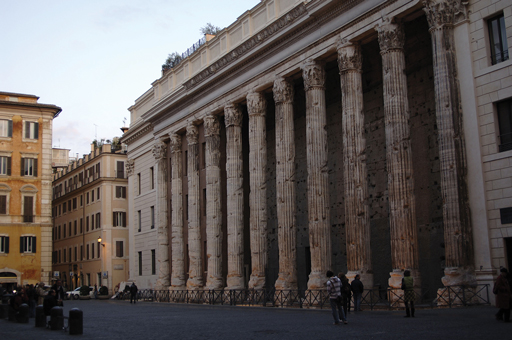2.3 The Temple of Deified Hadrian
Your study of Hadrianic monuments in Rome concludes with another temple associated with his successor, Antoninus Pius – the Temple of Deified Hadrian.
Figure 14 shows what survives of the temple. There are 11 Corinthian columns of Proconnesian marble and part of the cella wall, as well as part of the lower entablature. Excavations behind the railings have revealed part of a podium of local peperino tufa. There is no inscription to identify the temple, but the architectural style belongs to the late Hadrianic or early Antonine period. This, along with the temple’s location in the Campus Martius, has led archaeologists to identify it as the Temple of Deified Hadrian, which Antoninus Pius dedicated in 145 CE. Another large temple precinct nearby may be that of Hadrian’s mother-in-law, Matidia, and her mother (Trajan’s sister), Marciana, who were deified after their deaths (see Section 3). A series of marble panels found in the vicinity may have decorated the Temple of Deified Hadrian or another public building nearby. These are interesting because they are carved with personifications of cities and peoples of the Roman empire, alternating with images of military and naval trophies (see Hughes, 2009 for discussion).
The harmonious composition we see on the Hadrianeum represented the empire at peace and running smoothly. Mary Boatwright presents a similar idea in her discussion of the Temple of Venus and Rome, part of which you studied as Reading 1.
In the iconography of both temples the emperor may have been trying to create a positive image of the authority of Rome. Nevertheless, these temples and others were a constant reminder of who was in control in Rome and in the empire: the emperor.
Section 2 has focused on temples associated with Hadrian. In the final part of this course on Hadrianic Rome you’ll explore how Hadrian wove himself and the imperial family into the fabric of the city even after their deaths.

